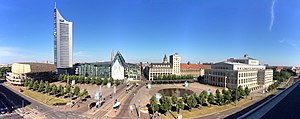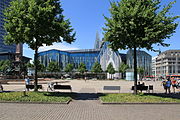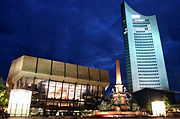
Leipzig, with a population of 628,718 inhabitants as of 2023, is the most populous city in the German state of Saxony, the second-most populous city in the area of the former East Germany after (East) Berlin, and Germany's eighth-most populous. Leipzig/Halle Airport is situated in Schkeuditz, between Leipzig and Halle (Saale). The name of the city and those of many of its districts are of Slavic origin.
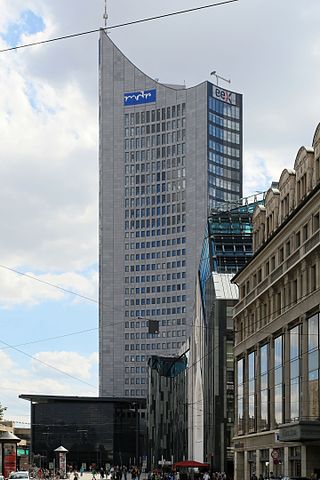
City-Hochhaus is 36-story skyscraper in Leipzig, Germany. At 142 m (466 ft), it is the tallest multistory building in Leipzig and is located proximately of the eastern part of the inner city ring road in Leipzig's district Mitte. The tower was designed by architect Hermann Henselmann in the shape of an open book, and built between 1968 and 1972. It followed Henselmann's idea to cap central places in cities with a prominent tower, such as the Jen-Tower in Jena and Fernsehturm in Berlin.
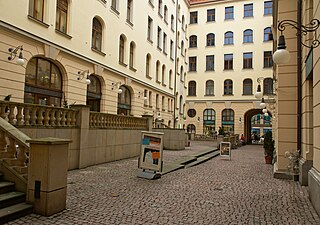
The Städtisches Kaufhaus in Leipzig, designed by the municipal architects Rayher, Korber and Müller in the style of Baroque Revival architecture, was constructed from 1894 to 1901.
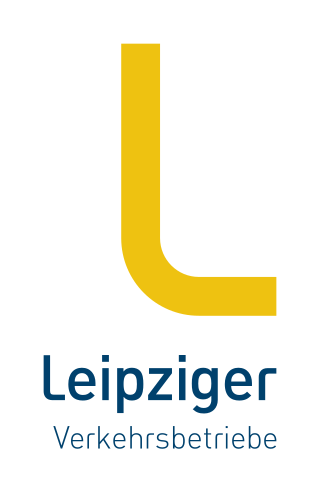
The Leipziger Verkehrsbetriebe (LVB), literally translated into English as the Leipzig Transport Authority, operates the tramway and bus transport services in Leipzig, Germany. The LVB network is a part of the regional public transport association, the Mitteldeutscher Verkehrsverbund (MDV). The LVB was formed by the merger, from 1 January 1917, of two predecessor undertakings, the Großen Leipziger Straßenbahn and the Leipziger Elektrischen Straßenbahn. The merged undertaking was also known as GLSt until it was reorganized and renamed as the LVB, from 29 July 1938.
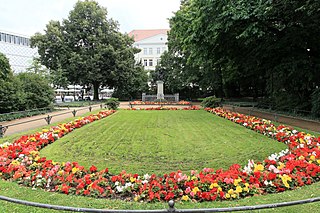
Goerdelerring is a street and major tram interchange station in Leipzig, Germany. It is named after Carl Friedrich Goerdeler.

The Augusteum was a building on the Augustusplatz in Leipzig, Germany, to the left of the Paulinerkirche. It was built on the 1543 site of the University of Leipzig and served as its main building.

The Paulinerkirche was a church on the Augustusplatz in Leipzig. It was built in 1231 as the Klosterkirche St. Pauli for the Dominican monastery in Leipzig. From the foundation of the University of Leipzig in 1409, it served as the university church. After the Protestant Reformation it was donated to the university and was inaugurated in 1545 by Martin Luther as the Universitätskirche St. Pauli, later also called Unikirche. Johann Sebastian Bach was director of music for "festal" (holiday) services in 1723−25.
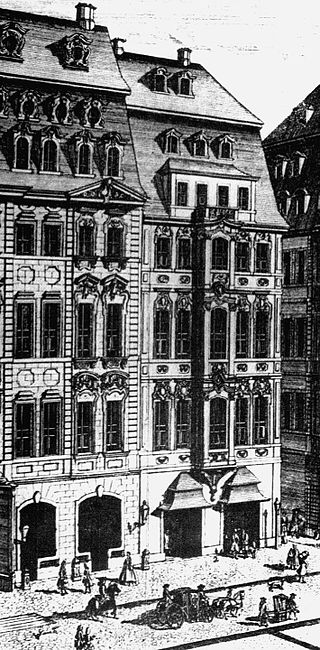
The Café Zimmermann, or Zimmermannsches Kaffeehaus was the coffeehouse of Gottfried Zimmermann in Leipzig which formed the backdrop to the first performances of many of Bach's secular cantatas, e.g. the Coffee Cantata, and instrumental works.
Richard-Wagner-Platz is a square in Leipzig in the northwest of Leipzig city centre within Leipzig's "ring road" on the northwest corner. The square is named after the composer Richard Wagner, whose house of birth was nearby.
Felix Rudolf Skoda was a German architect and academic teacher. He was chief architect for the Neue Gewandhaus in Leipzig.

Alte Messe Leipzig is the circa 50 hectares site in the southeastern part of Leipzig's district Mitte, where from 1920 until 1991 the technical exhibitions of the Leipzig Trade Fair took place, as well as the buildings that stand on it – but not the trade fair itself, which found a new home at a new site in the northern part of Leipzig. Since 1996 there has been no trade fair activity on the old site.

The Inner City Ring Road in Leipzig in the district of Mitte is the ring road around Leipzig's city centre. It encloses the just 0.7 km2 large area of the old town without the former Vorstadts.
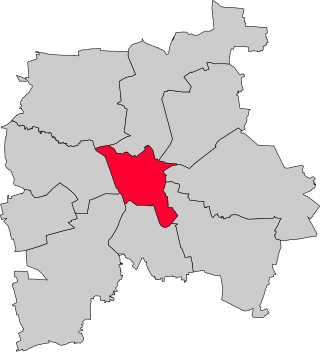
Leipzig-Mitte is one of ten boroughs (Stadtbezirke) of Leipzig, located in the center of the city. It includes numerous architectural monuments. Most of them are located in the subdivision "Zentrum", which is sited inside the Inner City Ring Road and the Promenadenring:

The Europahaus in Leipzig is a 13-storey and 56 m (184 ft) tall listed office building at Augustusplatz 7.

The Promenadenring Leipzig is the oldest municipal landscape park in Germany and one of the most important garden and cultural monuments in the city. The term is also used as a synonym for Leipzig's inner city ring road, a traffic facility that is connected to the green spaces of the Promenadenring. Like the inner city ring road, the promenade ring is about 3.6 kilometers long (2.24 mi.).

The Rundling, also called "Nibelungensiedlung", is a circular housing estate in the southern part of Leipzig in the Lößnig neighborhood.

The Wintergartenhochhaus is a 32-story high-rise building in Leipzig-Mitte, subdivision Ostvorstadt. The residential building was built from 1970 to 1972 as Wohnhochhaus Wintergartenstraße and is the third tallest high-rise in Leipzig after the City-Hochhaus and the Hotel The Westin. With a total height of 106.8 m (350 ft) and 95.5 m (313 ft) roof height, it was the tallest residential building in the East Germany and is now in the top hundred on the list of high-rise buildings in Germany. As a building of modernity and testimony of East German architectural history with rarity value, it is under cultural heritage protection.

The Markt is a square of about 1 ha in Leipzig's district of Mitte, Germany. It is considered the center of the city. The Old Town Hall stands on it, which demonstrates its particular historical importance. The square was named Platz des Friedens from 1950 to 1954. Its paving is a listed heritage monument.

Grimmaische Strasse is a street in Leipzig, borough Leipzig-Mitte, and connects the marketplace with Augustusplatz. It was named in 1839 after the Grimmaischer Tor, the gateway to Grimma, which was first mentioned in 1421. Before that it was called Grimmaische Gasse and was the main street of the Grimma quarter. Today it is a heavily frequented pedestrian zone in a prime location with department stores, shops, restaurants, hotels, a museum and the university as residents.
